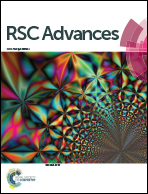Organic–inorganic binary mixture matrix for comprehensive laser-desorption ionization mass spectrometric analysis and imaging of medium-size molecules including phospholipids, glycerolipids, and oligosaccharides†
Abstract
Matrix-assisted laser desorption/ionization mass spectrometry (MALDI-MS) is a widely adopted, versatile technique, especially in high-throughput analysis and imaging. However, matrix-dependent selectivity of analytes is often a severe limitation. In this work, a mixture of organic 2,5-dihydroxybenzoic acid and inorganic Fe3O4 nanoparticles is developed as a binary MALDI matrix to alleviate the well-known issue of triacylglycerol (TG) ion suppression by phosphatidylcholine (PC). In application to lipid standards and maize seed cross-sections, the binary matrix not only dramatically reduced the ion suppression of TG, but also efficiently desorbed and ionized a wide variety of lipids such as cationic PC, anionic phosphatidylethanolamine (PE) and phosphatidylinositol (PI), and neutral digalactosyldiacylglycerol (DGDG). The binary matrix was also very efficient for large polysaccharides, which were not detected by either of the individual matrices. The usefulness of the binary matrix is demonstrated in MS imaging of maize seed sections, successfully visualizing diverse medium-size molecules and acquiring high-quality MS/MS spectra for these compounds.


 Please wait while we load your content...
Please wait while we load your content...